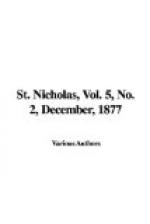In this poem each stanza, we may say each line, is unalloyed gold. Let us examine the first line.
“Mary.” The name strikes us at once as belonging to one pure as the inside of an apple-bloom; and the rest of the poem assures us, that by making Mary’s name an index to Mary’s character, we have not been misled. A master’s hand is visible from the first word.
“A little lamb.” The poet does not take for granted, as one of less genius would, that because a lamb is mentioned the reader necessarily sees in his mind’s eye one of the frolicsome, gentle, confiding creatures commonly accepted as an emblem of meekness. Not at all. The lamb is not only a lamb—it is a little lamb. Thus never in the whole course of the poem can we by any oversight look upon Mary’s treasure as a sheep; it retains its infantile sweetness and grace through the entire narration. The poet thus draws our attention to the youth of the animal, in order to palliate the little creature’s after-guilt. This is done with such grace and delicacy, that it is scarcely perceptible.
The line, as a whole, shows a touch of high art seldom seen in so short a poem. The writer knows human nature—that, we see at a glance. Else, would he not have entered into a detailed account of Mary’s parentage, her appearance, place of residence, or, at least, the manner in which she became possessed of the lamb. But no; all is left to the imagination. Mary may be as blonde as the “Fair one with golden locks,” as dark as “Black Agnes.” Each reader has a heroine after his own heart, and each is satisfied.
“Its fleece was white as snow.”
No black sheep (or lamb) could we in any way imagine as a companion of Mary—gentle, affectionate, pure little Mary. All her associates must be pure as herself.
“And everywhere
that Mary went
The lamb was sure
to go.”
Does not this suit the character given to Mary by her name? We can image to ourselves the lost lamb, the mournful bleating for its mother, its hunger and cold. In the depth of its misery we see Mary’s sweet face bending pityingly over it; she raises it, takes it home, it revives, and loves her; she loves it in return. Can we wonder that it follows in her footsteps wherever she goes? Those two lines tell more than many a volume; but they must be read feelingly, or all is lost.
Now follows a tale of wrong-doing and of subsequent punishment. This is, indeed, a master-stroke; for this climax we were not prepared.
“It followed her
to school one day,
Which was against
the rule.”




